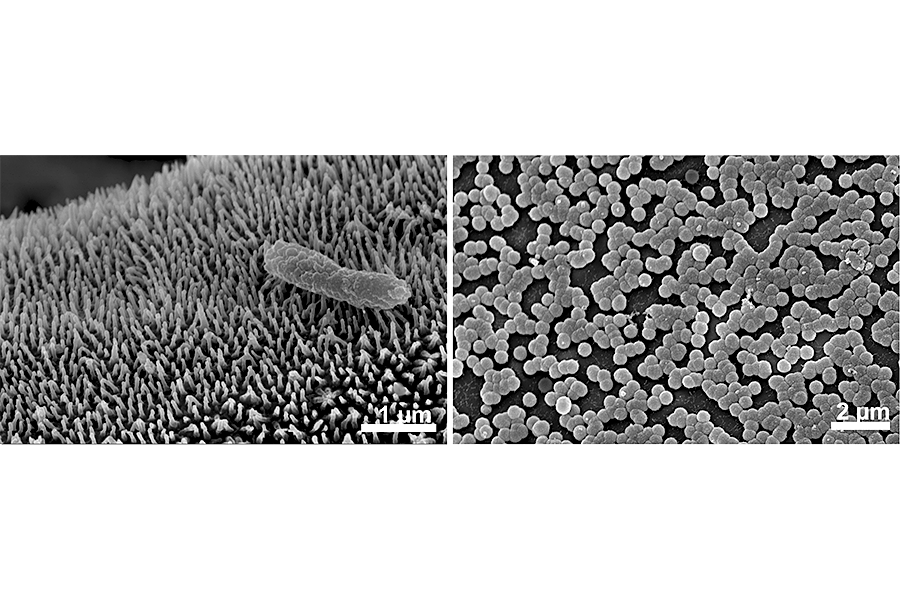Is this tiny transparent ocean animal wearing an invisibility cloak?
Loading...
Out in the open ocean there is no place to hide from a hungry predator. Marine animals must devise novel ways of going undetected in plain sight.
Being translucent, like most of the little crustaceans that belong to the suborder Hyperiidea, can help. Still, savvy predators can glimpse the tasty morsels floating around when light glints off of their bodies.
But the shrimp-like animals have a trick up their sleeves for just that scenario, according to new research published Thursday in the journal Current Biology. The crustaceans are covered in a thin antireflective layer, making the animal's bodies and legs as much as 250 times less reflective.
"These animals are famous for being hard to see" with their highly transparent bodies, Tom Cronin, a biologist at the University of Maryland, Baltimore County who was not part of the research, tells The Christian Science Monitor in a phone interview.
But even see-through, it's still difficult to be invisible, he says. And this study "shows that animals actually can address other aspects of invisibility, ones that are less obvious than just being transparent."
When Laura Bagge, a Ph.D. candidate at Duke University, and colleagues looked at seven species of Hyperiid amphipods under an electron microscope, they found that the crustaceans were covered in a film of tiny spheres that were all uniform in size.
It's a lot like the technology used on anti-glare eyeglasses, Ms. Bagge explains in a phone interview with the Monitor. These small beads reduce the amount of light reflected off the surface, instead allowing more light to pass through it.
The result is anywhere from a fourfold to a 250-fold decrease in light reflected off the animal, according to modeling Bagge and her colleagues conducted in the lab.
The researchers aren't sure exactly what those little spheres are made of. They aren't part of the animal's hard shell or any other part of the organism itself, Bagge says. "Our best guess is that it's actually living bacteria," she says. Those tiny bacteria presumably have some sort of symbiotic relationship with the crustaceans.
The nanosphere blanket wasn't all that Bagge and her colleagues found atop the small sea creatures. The largest of the seven species studied, Cystisoma, also has brush-like structures growing out of its legs. These structures actually grow out of the six-inch-long animal's exoskeleton and act in the same way as the antireflective beads blanketing the animals, disrupting reflection so light can more easily pass through the transparent animals.
"It's always amazing to see the various solutions animals have come up with to adapt best to their environment," Lydia Mäthger, a scientist in the Marine Biological Laboratory in Woods Hole, Mass., who was not part of the research, writes in an email to the Monitor.
Other animals have found other ways to camouflage their bodies in highly visible marine environments. For example, Dr. Mäthger says, cephalopods (squid, octopus, and cuttlefish) have structures that can scatter light in various ways or reflective structures that are angled to only be seen from one direction. And, she adds, cephalopods can also turn reflective mechanisms on and off, going from transparent to opaque, to become invisible to different types of predators.
But, Mäthger says, "A reflection-reducing structure, such as reported here, is a fascinating new finding."
This newfound antireflection mechanism likely isn't just about protecting the animals from predation, Dr. Cronin points out. These animals are also aggressive predators in their own right and this sort of invisibility cloak might also help the crustaceans sneak up on jellyfish, salps, and other unsuspecting prey.
And just as the crustaceans have evolved to move around undetected, their predators must evolve ways to better detect them, Mäthger adds, "so what visual strategies might we expect from the predators that these amphipods are hiding from?"
These camouflage adaptations likely have driven unique visual adaptations in other animals too, she says.
Bagge and her colleagues still have many questions about the new structures.
One lingering puzzle is whether or not those tiny spheres are actually bacteria as suspected. Animals are normally covered in many microbes, but they're not typically uniform in size like these spheres appear to be on the crustaceans. Furthermore, at about 50 nanometers, these beads are significantly tinier than any recorded bacteria.
"We don't have another hypothesis about what it could possibly be," Bagge says. Perhaps they are from another kingdom of microbes, Archaea, she says, or are little pieces of bacteria that have broken off. But for now, she says, "Bacteria is the best guess."
And if the researchers are right and it does turn out to be bacteria, Cronin says, "It's another view of how very different creatures can work together for mutual benefit."









